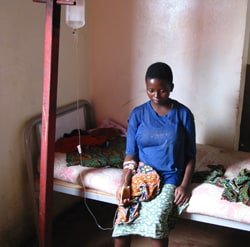Treatment

A patient in the Democratic Republic of Congo receiving treatment for stage 2 sleeping sickness.
Anyone diagnosed with African Trypanosomiasis should be treated with specific drug and treatment course. Treatment depends on type of infection (T. b. gambiense or T. b. rhodesiense) and disease stage (i.e., presence or absence of central nervous system involvement).
Depending on age and weight of the patient, pentamidine or fexinidazole may be used for treatment of first stage (and for fexinidazole, certain second stage) T. b. gambiense infections. These drugs are available in the United States.
Depending on age and severity of infection, treatment for second stage T.b. gambiense infections may include nifurtimox eflornithine combination therapy (NECT) or fexinidazole. Nifurtimox is FDA approved and commercially available in the US. Providers can obtain and prescribe nifurtimox under the practice of medicine in combination with eflornithine for treatment of certain second stage T. b. gambiense infections based on severity of disease. Eflornithine is not commercially available in the US but can be obtained from CDC.
Suramin and melarsoprol are used to treat first and second stage T. b. rhodesiense infections, respectively. They are not commercially available in the United States but can be obtained from CDC. Physicians can consult with CDC staff to obtain these treatment drugs.
There is no test of cure for African trypanosomiasis. After treatment, patients should be closely followed for 24 months and monitored for relapse. Recurrence of symptoms will require examination of body fluids, including CSF, to detect the presence of trypanosomes.